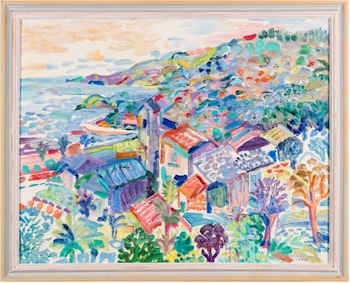
Fred Yates (1922-2008): Cotes d'Azure - signed bottom right; oil on board; 58x74cm.
PICTURE THIS ........ It's all about the paint for Fred Yates.
Fred Yates was born in Lancashire on a Summer day in 1922. A lazy search of
the Internet throws-up enough information to piece together a brief biography, some
of which is probably true. Yates was sensitive and gentle in manner, also reclusive
and could 'lose himself' while immersed in painting. He is described as 'untaught'
and 'untutored', which rather contradicts his 'formal education in drawing, printmaking
and painting' in Bournemouth, and his scholarship to Rome.
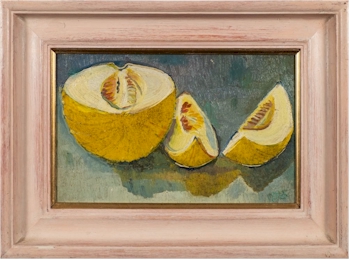
Fred Yates (1922-2008): Melon - signed bottom right; oil on board; 18x29.5cm.
In 1954, Yates was judged second in a painting competition and there was possibly
a mixture of excitement and relief for the shy and retiring Yates, as the declared
winner of the competition was LS Lowry, an admired and an acknowledge influence
on Yates. By the time of his prize-winning, Yates and his generation had lived through
a War. He had served with the Grenadier Guards and probably the most profound effect
of the War on Yates was the loss of his twin brother, posted missing-in-action during
an assault at Arnhem in September 1944.
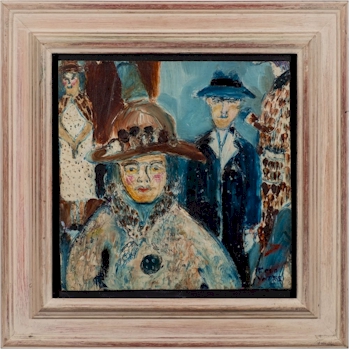
Fred Yates (1922-2008): Sunday Best Hats - signed bottom right; oil on board, 30.5x30.5cm.
It is impossible for most of us to imagine the effects a personal tragedy like this
and what the other events of the War would have. One effect of the trauma on Yates
was a sense of isolation and, having lost his brother, a fear of forming close relationships.
In the late 1960s, a progressively more reclusive and private Yates decided to commit
more to his passion for painting and he moved to Cornwall, where he painted plein
air using collected materials and household paints. In 1976, he held a
solo show in Plymouth, eventually making an exhibition in London in 1992. Yates'
paintings are in the British tradition of Lowry and Alfred Wallis, each of whom
has been described as solitary, self-taught and naive, but all who have a particular
popular appeal.
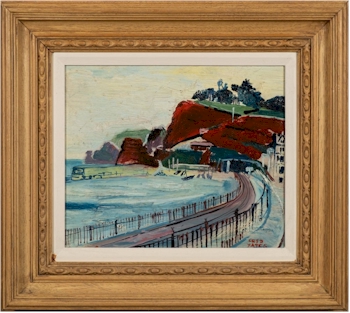
Fred Yates (1922-2008): Dawlish Sea Front - signed bottom right; oil on board; 22x26.5cm.
So, why do 'we' like paintings by Fred Yates, and for that matter Lowry, Wallis,
Helen Bradley and the more contemporary Simeon Stafford? Maybe we don't all
like them and these untraditional painters have certainly had their detractors in
the past. Do we sheepishly become influenced by fashion and the zeitgeist? Are we
persuaded we like something, or do we persuade ourselves?
Look carefully at paintings by Yates. They are well observed and sensitively capture
vignettes of contemporary life. Yates set out to paint pictures of the lives of
ordinary people: "It's the man in the street that I'm after ........ he is the
one I want to please and enchant by means of my work".
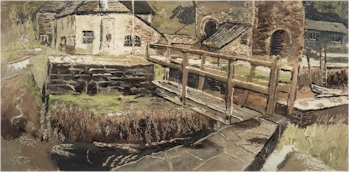
Fred Yates (1922-2008): Pont Mill, Lostwithiel, Cornwall - signed bottom left; oil
on board; 61x122cm.
The style and technique of Yates creates tactile three-dimensional-feeling images
somewhere within deep, thick impasto. And within these bulging, crested surfaces
is where our attention tends to focus and this becomes a point of difference.
The Yates surfaces are emphasised by their volume and presence and we become obsessed
with them. Before we know it, our attention is deflected and we are drawn-in, engaged
and immersed deep within the scene and the paint and impasto. Form and composition
in the paintings are dominated by the physical mass of the surface and our tactile-visual
engagement enlivens and stimulates senses of touch and sound and smell.
Now we are hooked. Appreciation of a painting doesn't have to be based in fact or
evidence or vision. I recall serious and academic articles and lectures about Mark
Rothko and his monumental abstract 'floating fields of colour' canvases, and discussions
about the picture surface and meaning. Rational would say that the picture surface,
where the paint on the canvas, is what it is all about and, therefore, comes first
and foremost. But as the debate heated-up, maybe the picture and the purpose and
meaning of the painting, didn't actually exist there on the surface. Maybe to read
and understand the picture we had to experience and feel it 'somewhere else' other
than on the physical surface of the canvas. What a ridiculous proposition; or is
it?
Paintings by Fred Yates (1922-2008) regularly come-up at our auctions in Exeter
and typically make from £500 to £5,000.
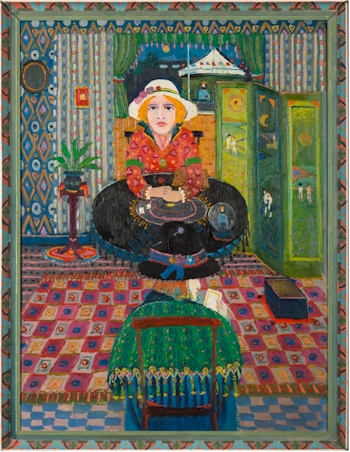
Fred Yates (1922-2008): The Fortune Teller - signed within the crystal ball on the
table; oil on canvas; 99x74cm, within the artist's painted frame.
- Bearnes Hampton & Littlewood
- Fred Yates (1922-2008)
- LS Lowry
- Alfred Wallis
- Helen Bradley
- Simeon Stafford
- Mark Rothko
Fred Yates was written on Friday, 1st November 2019.










